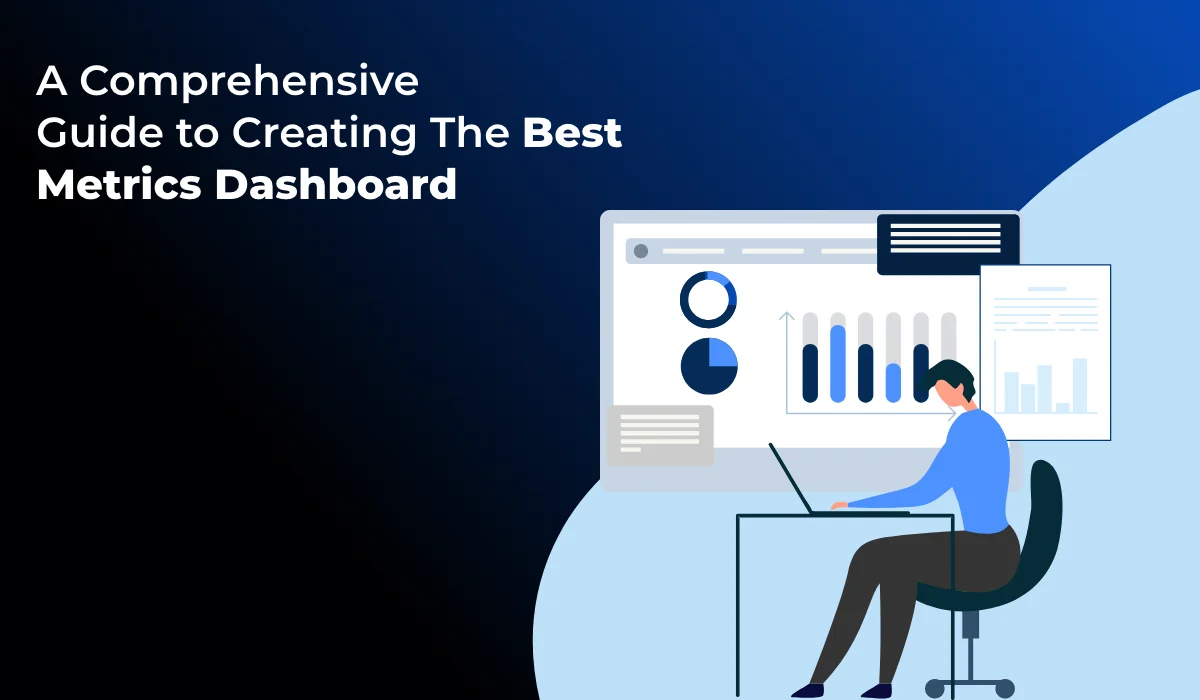A Comprehensive Guide to Creating The Best Metrics Dashboard

Published on: April 28, 2023
Updated on: July 08, 2024
2237 Views
- Analytics
18 min read
The best marketing companies use a wide range of key performance indicators (KPIs) and make data-driven decisions to excel in the highly competitive market today. They create well-defined metrics dashboards to get a comprehensive view of the business and monitor the effectiveness of their marketing exercises.
In this blog post, we will look at how you can also create the perfect metrics dashboard for your business and harness the power of data to drive business decisions.
Create Metric Dashboard: A Powerful Tool for Business Decision Making
Looking to improve your business decision making process? Consider implementing a dashboard. A metric dashboard is a representation that displays data and key performance indicators (KPIs) giving you valuable insights into your business's performance. With this tool you can track, monitor and analyze metrics and trends in time empowering you to make informed decisions and enhance overall business performance.
Metric dashboards play a role in the decision making process by providing an encompassing view of your business performance. Whether you're a business owner, manager or analyst, having a dashboard allows you to gain a perspective on essential metrics like sales, revenue, customer satisfaction, website traffic and more.
The advantages of utilizing dashboards for monitoring and analysis are substantial. Firstly they save time and effort by consolidating data from sources into one to understand visual format. This not reduces the work required for gathering and analyzing data but also minimizes the risk of errors or inaccuracies. Secondly metric dashboards enable decision making by providing real time insights.
By waiting for reports or manually sifting through data you have the ability to keep tabs on your business's performance in time and promptly address any issues or seize opportunities. Additionally metric dashboards promote collaboration and communication, within teams by fostering a shared understanding of the business performance and goals. This cultivates alignment among team members towards objectives and facilitates data driven discussions.
To summarize, crafting a dashboard is a means of enhancing your business decision making process. It not only offers a snapshot of your business performance but also empowers you to make informed choices based on data, encourages teamwork and drives overall business growth. So why wait? Start harnessing the power of dashboards today!
Grasping Metrics and KPIs
To develop a Metric Dashboard it is crucial to comprehend the distinction between metrics and Key Performance Indicators (KPIs).
Distinguishing metrics from KPIs
Metrics are measurements utilized to track and evaluate aspects of a business or project. They provide data that aids in monitoring performance, identifying trends and measuring progress, towards goals.
On the other hand KPIs are a subset of metrics specifically chosen to reflect the success factors of a business or project. They are measurable, actionable and directly linked to objectives.
Key Performance Indicators (KPIs) play a role in assessing performance and tracking progress towards goals.
Metrics come in forms. Are often grouped into different categories.
Here are some examples:
- Financial metrics- Revenue, profit margin return on investment
- Operational metrics- Cycle time, defect rate, customer satisfaction score
- Marketing metrics- Conversion rate, bounce rate, customer acquisition cost
While all KPIs are considered metrics, not all metrics qualify as KPIs. KPIs possess characteristics that set them apart from metrics.
These characteristics include:
- Relevance- KPIs directly align with the organization's objectives and strategic goals.
- Clarity- KPIs are clearly defined, easily understood and consistently measurable.
- Measurability- KPIs can be quantified and tracked over time to assess performance.
- Actionability- KPIs provide insights and actionable information that drive decision making and foster improvement.
The significance of selecting metrics and KPIs for your dashboard cannot be overstated. Carefully choosing these indicators ensures that the dashboard delivers insights to facilitate informed decision making.
When we focus on the indicators the dashboard becomes a valuable tool for monitoring performance identifying areas for improvement and driving actionable change. However choosing irrelevant or ineffective metrics can overwhelm us with information. Make it difficult to make data driven decisions.
Planning and Designing the Metric Dashboard
Creating a dashboard requires careful planning and design to effectively convey the desired information. This section will guide you through the steps of this process.
Identifying the Objectives of the Metric Dashboard
The first step in planning a dashboard is to define its objectives. What do you intend to accomplish with the dashboard? Are you aiming to monitor sales performance, analyze marketing campaigns or track customer satisfaction?
To create an actionable dashboard it's crucial to have an understanding of your goals. Clearly defining these objectives will help you choose metrics and Key Performance Indicators (KPIs) for your dashboard.
Understanding the Target Audience and Their Specific Requirements
Knowing who will be using the dashboard is important, in meeting their needs. Different stakeholders may have varying information requirements and preferences when it comes to visualizing data.
For instance the Chief Financial Officer (CFO) might be interested in metrics whereas the marketing manager may focus more on campaign analytics. By understanding the needs of each audience you can customize the dashboard to meet their requirements and ensure that it delivers value to them.
Choosing the Right Metrics and Key Performance Indicators (KPIs) that Align with Business Objectives
Metrics and KPIs are elements of a dashboard. They offer insights into the performance and health of aspects of the business.
When selecting metrics and KPIs it is essential to align them with the business goals. For example if your aim is to enhance customer satisfaction you could incorporate metrics, like Net Promoter Score (NPS) or customer retention rate.
It is vital to opt for relevant and measurable metrics and KPIs. They should provide information that facilitates decision making and enables progress tracking towards your business goals.
Organizing and Structuring the Dashboard for Information Communication
The organization and structure of your dashboard significantly influence its effectiveness. It should have a design that allows users to quickly locate the information they require.
A structured dashboard will feature a layout where related metrics are grouped together.To make it easier for users to understand and gain insights, from the data you can incorporate cues like color coding or grouping metrics under headings. It's important to consider the design of the dashboard well using appropriate fonts, colors and contrast to enhance readability. Keep the design clean and focus on presenting information in a concise manner.
When developing and designing your dashboard it's crucial to follow principles. These principles will help you create an user-friendly dashboard that meets your specific requirements.
The process of developing a dashboard involves stages. First determine the purpose and goals of the dashboard so that you can identify which metrics and key performance indicators (KPIs) need to be tracked. Once you've defined these metrics choose the tools and platforms for creating your dashboard.
There are tools and platforms for creating metric dashboards.The decision relies on factors such as budget, technical needs and desired functionality. There are tools available like Tableau, Google Data Studio and Microsoft Power BI. These tools offer a range of features and flexibility to tailor the dashboard according to your needs.
Effective Strategies for Creating Visually Appealing and User Friendly Dashboards
Creating an user friendly dashboard requires careful consideration of the layout, color scheme and data visualization techniques.
Here are some recommended practices to follow;
1. Simplify the layout- Keep the layout clean and organized by using headings and sections to categorize metrics.
2. Choose colors- Select color schemes that're visually pleasing and align with your brand identity. Use colors strategically to emphasize information.
3. Visualize data effectively- Utilize charts, graphs and other visual elements to present data in a way. Avoid cluttering the dashboard with visuals while ensuring they are easy for users to comprehend.
4. Ensure accessibility- Take into account accessibility principles during dashboard design. Provide text for images. Ensure that users with disabilities can access the content easily.
Tailoring Dashboard Layouts and Features According to Specific Requirements
Every organization has requirements when it comes to dashboards. It is crucial to customize the layout and features of the dashboard in order to meet these needs.
You can enhance the functionality of the dashboard by incorporating widgets integrating data sources or including interactive elements that facilitate, in depth analysis. By adhering to these development and design principles you will be able to create a dashboard that not effectively showcases important data but also facilitates well informed decision making.
Identify Your Business Goals and KPIs
Before creating a metrics dashboard you must first decide the KPIs that align with your business goals.
These KPIs should answer the most important questions about your business like:
- Top priorities of the business
- Methods of measuring success
- Necessary metrics you should track to achieve business goals
Once you have a clear understanding of that you can align your team’s efforts in that direction and ensure that they are working towards a common goal. Moreover, with a clear vision, you can also identify the areas of improvement and take the required actions.
Here are a few examples of commonly used KPIs across different industries:
eCommerce
- Average order value
- Abandonment rate
- Conversion rate
Marketing
- Lead generation
- Cost per acquisition
- Website Traffic
Finance
- Net profit
- Return on investment (ROI)
- Revenue
Some of the Most Popular Metric Dashboard Tools
When it comes to choosing the right metrics dashboard tool for your business, you cannot invest your money without considering a wide range of factors. Before we discuss these points, here are some of the most popular metrics dashboard tools to choose from.
- Google Analytics: Web analytics tools to track website traffic and performance that also offers insights into user behavior, acquisition channels, and more.
- Tableau: Data visualization tool used to create dashboards and reports that are interactive.
- Microsoft Power BI: Business intelligence tool that enables users to create dashboards and reports that are interactive and use a drag-and-drop interface.
Factors to Consider When Choosing a Metrics Dashboard Tool
Now that you have an idea of the most popular metric dashboard tools, let’s look at the factors to consider when choosing one for your business.
- Your preferred tool should integrate with different data sources like Google Analytics, social media, and other platforms.
- It should be easy to use and offer a user-friendly interface
- You should be able to customize your dashboard layout to visualize and display the key metrics effectively
- It should be sensibly priced and should be free of any hidden charges concerned with integrations and data storage
Choosing a Metrics Dashboard Design
After completing the steps above and identifying the KPIs you need to focus on, it is time to finalize the metrics dashboard design. You can simplify this process by incorporating the following best practices.
- Keeping the dashboard clear of any unnecessary information and keep things simple by focusing on the most crucial metrics you want to track.
- All your users should be able to understand your metrics dashboard. So, you must keep simple labels to avoid any confusion.
- Choose a clean layout that is easy to navigate and visually appealing to your users.
- Always use visualizations like charts and graphs to help your users understand the data easily and identify trends.
- Make sure your metrics dashboard is tailored to the needs of your target audience.
There are several metric dashboard layouts you can use including single-page dashboards, tabbed dashboards, metric cards, and color coding. You can also choose the visualization types for your metrics dashboard like line charts, bar charts, pie charts, heat maps, and more to represent your data effectively.
Setting Up a Metrics Dashboard Using a Popular Tool
After completing the steps mentioned above, it is time to set up your metrics dashboard. You can follow these steps to get started with your dashboard using popular tools.
- Create your account with your preferred metrics dashboard tool.
- Connect your data sources to the dashboard, which may include data from sources such as Salesforce, Google Analytics, and other related sources.
- Define the metrics that are of particular interest to you, and include them in your dashboard.
- You may opt to use a pre-defined metrics dashboard template, or go ahead and create a customized one that aligns with your business needs.
- After this, select the most fitting visualizations that are in line with your business, and integrate them into your dashboard.
- Make the dashboard interactive and visually appealing by adding customized labels, colors, and design elements.
- Initiate alerts and notifications whenever a user makes changes to your dashboard.
Maintaining and Optimizing Your Metrics Dashboard
After creating your dashboard, it is time to look after it. By maintaining and optimizing your dashboard you can be rest assured that it continues to deliver the information you need to make informed business decisions.
Here are a few reasons why you should maintain your dashboard.
- It ensures that all your data sources are up-to-date and accurate
- You can review and update your KPIs and keep things in sync with your business goals
- By optimizing your dashboards for speed and performance you can make them more accessible and usable
- With constant monitoring, your can track and troubleshoot any potential issues before they cause damage to your data
Now that you have a clear understanding of what to do when establishing your metrics dashboard, here is a list of things you should completely avoid during this process.
- Overloading your dashboard with excessive information or visualization as it makes it difficult to navigate through the data
- Failing to review and update your dashboard can lead to inaccurate or outdated data
- Not implementing the right security measures makes your data vulnerable to unauthorized access or data breaches
- Ignoring the needs of your audience when designing the dashboard can make it difficult for others to understand your dashboard
Collecting and Analyzing Data
To create a dashboard the most important aspect is accurately collecting relevant data. If the data isn't accurate the metrics displayed on the dashboard can hinder decision making processes. That's why it's crucial to give attention to data collection.
Once we have collected the data we need to analyze it to derive insights. Data analysis helps us understand performance trends and identify areas for improvement.
It's also important to integrate data sources. A good metric dashboard should be capable of gathering data from databases, APIs and spreadsheets. This ensures that the dashboard presents a view of metrics.
Visualizing data is essential for presentation. By using charts, graphs and other visual elements we can simplify data. Make it easier to understand and interpret. Visual representations also help in identifying patterns and trends that may not be immediately apparent in data.
Tracking Metrics and Monitoring Performance
Efficiently tracking metrics and monitoring performance is vital, for optimizing your business performance and achieving your goals.
To guarantee reliable data collection it's important to establish systems and processes, for consistent data tracking. Once you have defined your metrics and key performance indicators (KPIs) it becomes crucial to establish performance benchmarks and goals for each metric. These benchmarks will serve as a reference point helping you monitor progress towards your desired outcomes effectively.
Real time monitoring of data plays a role in identifying trends and making timely decisions. By tracking and analyzing your metrics you can stay informed about the performance of your business. Promptly respond to any changes or challenges that may arise.
Using a designed dashboard allows you to visualize the performance of your key metrics quickly. This proactive approach empowers you to address performance issues and make decisions based on data ultimately driving growth.
Reporting and presenting results
Once you have designed and developed a dashboard the next step involves reporting and presenting the results to stakeholders. This step is crucial because it ensures that the data collected and analyzed is presented in reports that provide insights for informed decision making.
Creating reports from the dashboard
When creating reports, from the metric dashboard it is essential to include all relevant metrics and KPIs that offer a holistic view of performance.This includes both high level summaries and detailed information to support insights based on data analysis. By consolidating data from sources the reports offer an overview of overall performance identifying trends, patterns and areas, for improvement. It is important to use concise language in the report to ensure it can be easily understood by all stakeholders.
Selecting formats and visual aids for presenting findings
The choice of formats and visual aids for presenting findings plays a role in communicating the insights derived from the metric dashboard. Using graphs, charts and visualizations can make complex data easily understandable and engaging for the audience.
Depending on stakeholder needs reports can be presented in formats like PowerPoint presentations, written summaries or interactive dashboards. The key is to choose a format that effectively conveys information while aligning with audience expectations and preferences.
Sharing dashboard reports with stakeholders for communication
Communication is essential when sharing dashboard reports with stakeholders. By providing access to dashboards and reports stakeholders gain insights into performance, objectives and progress towards goals.
Regularly updating and sharing reports with stakeholders ensures that everyone has access to the information promoting transparency and building trust.
Open communication plays a role in ensuring that stakeholders align their decision making processes with the goals and objectives of the organization.
Reports should be customized to cater to the needs and interests of audiences. This means tailoring the content to meet the requirements of each group. For instance executives may prefer summaries and key insights to aid decision making while operational teams may require more detailed metrics and performance indicators to identify areas for improvement. By personalizing reports according to the interests and needs of each audience the metrics dashboard becomes a tool that equips stakeholders with information for making informed decisions.
To make sure that your metrics dashboard remains effective in driving decision making and evolves with time it is important to assess its performance.
Regularly monitor how extensively the dashboard is used and track its performance metrics. This ongoing evaluation will help identify areas that can be improved or potential issues that need attention. Additionally analyze the data derived from the dashboard usage to gauge its impact on decision making processes as organizational goals.
Identify any gaps or inconsistencies in the data that may require investigation and resolution.
Collect feedback from users to pinpoint areas for improvement.
Engage with dashboard users, including stakeholders, managers and analysts to understand their experience using the dashboard.
Pose questions to gather insights about the usability, functionality and overall effectiveness of the dashboard in meeting users needs.
Consider conducting user surveys or interviews to obtain feedback on their satisfaction and suggestions, for enhancement.
Incorporate user feedback to improve dashboard features and usability.
By listening to user feedback you can identify areas where your metric dashboard can be improved to provide an user experience and deliver more relevant insights. Take the steps;
Implement changes recommended by users while considering their needs and pain points.
Continuously. Test features, designs and layouts to enhance usability and make information more accessible.
Collaborate with users and stakeholders throughout the process to ensure incorporation of their feedback.
Keep up with evolving requirements. Update the dashboard accordingly.
Metric requirements and priorities may change over time as your business evolves.To ensure that your dashboard remains relevant and impactful;
1. Stay informed about the industry trends, best practices and new metrics that can offer insights for your organization.
2. Continuously evaluate your organization's goals and objectives to identify any changes in requirements.
3. Collaborate closely with analysts and stakeholders to understand how these changes could affect your dashboard and make any updates.
By following these guidelines you can maintain a user metric dashboard that aligns with your organization's evolving needs.
Final Thoughts
A metrics dashboard plays a pivotal role in ensuring the success of your marketing activities. Additionally, it enables your business to analyze different KPIs and helps your marketing teams to make data-driven decisions.
In the long run it increases the efficacy of their marketing efforts, and yields a better ROI. By following the steps in this post, you can establish your metrics dashboard and start gainging invaluable insights that can assist you in outdoing your competitors and accomplishing your business objectives consitently.
Do you need some helo in creating a robust and optimized metrics dashboard for your comapny? Let's talk!
Digital marketing specialists at Growth Natives bring forth decades of cumulative team experience and assist in crafting marketing strategies that can propel your brand to new heights and turn your business into a revenue-generating powerhouse.
To know more about our services, email us at info@growthnatives.com or visit our website.
Frequently Asked Questions
Creating a metrics dashboard is important because it provides a centralized view of key metrics, enabling stakeholders to monitor performance, identify areas for improvement, and align strategies with business objectives. It promotes transparency, accountability, and data-driven decision-making.
Choose metrics that are relevant to your organization’s goals and objectives. Focus on a combination of leading and lagging indicators that provide a comprehensive view of performance across different areas of the business. Consider the audience and their informational needs when selecting metrics.
Key components of a good metrics dashboard include:
- Clear and relevant KPIs
- Intuitive and user-friendly design
- Real-time data updates
- Customizability to fit different user needs
- Interactive elements such as filters and drill-downs
- Visualizations like charts, graphs, and gauges
KPIs should be selected based on their relevance to the business goals and objectives. They should be specific, measurable, achievable, relevant, and time-bound (SMART), and directly tied to key business outcomes.
Common visualizations include:
- Line charts for trends over time
- Bar charts for comparing values across categories
- Pie charts for showing proportions of a whole
- Area charts for highlighting cumulative data trends
- Tables for displaying detailed data and comparisons
A metrics dashboard should be organized in a logical and intuitive manner, with related metrics grouped together. It should start with high-level summary metrics at the top, followed by more detailed breakdowns and comparisons. Interactive features like filters and drill-downs can provide flexibility for users to explore the data further.



